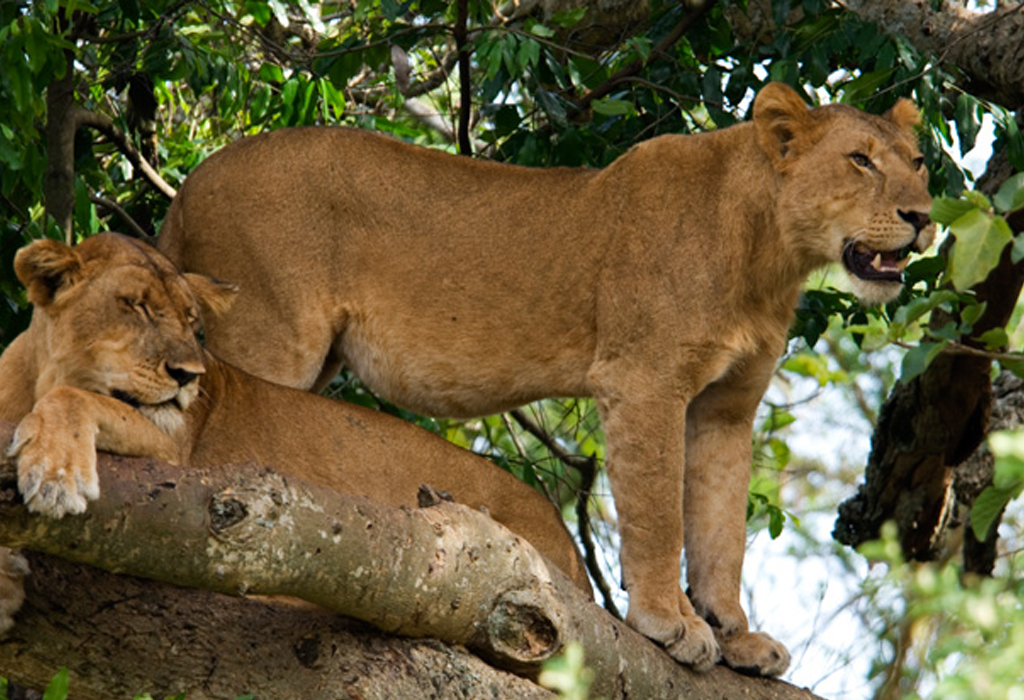
Top Five Benefits of Group Tours in East Africa
July 30, 2025
Top Activities to Experience in Kidepo Valley National Park
July 30, 2025Lion Tracking Experience in Queen Elizabeth National Park
Lion Tracking Experience in Queen Elizabeth National Park
Lion tracking in Queen Elizabeth National Park is one of the most thrilling wildlife experiences in Uganda. Situated in the southwestern region of the country, this park is among the most visited protected areas and is home to an abundance of wildlife including elephants, buffaloes, leopards, waterbucks, Uganda kobs, oribi, warthogs, hippos, and the famous tree-climbing lions found in the Ishasha sector.
This unique activity forms part of an experiential research program overseen by the Uganda Carnivore Project. The initiative aims to monitor and conserve lions while fostering positive relationships with local communities living near the park.
What Makes Lion Tracking Special?
Unlike a standard game drive, lion tracking is an interactive and educational experience. Conducted in the Kasenyi Plains, this activity allows a small number of visitors to join researchers in monitoring lions using radio collars and locator devices. The real-time tracking provides a rare opportunity to observe lions up-close, learn about their feeding habits, behaviors, social structures, and environmental adaptations, all while contributing to conservation data.
Climbing Lions
The information gathered during each tracking session is added to a growing database that supports long-term lion conservation efforts in the region.
How Lion Tracking Is Done
This activity is exclusive to Queen Elizabeth National Park and is typically carried out in the morning or evening when lions are more active. Researchers use radio telemetry a method involving radio collars and radiation locators to trace lion movements. When a lion wearing a collar is nearby, the device emits a signal, guiding the tracking team to its location.

Tracking usually lasts between 2 to 3 hours, during which participants may also encounter other wildlife species such as Uganda kobs, elephants, buffaloes, warthogs, and even the elusive leopard.
Group Size and Experience
To minimize stress on the animals and ensure a quality experience, the number of participants per session is strictly limited. This allows everyone to enjoy an intimate and undisturbed time observing the lions and taking photos while learning from expert guides and researchers.
Cost of Lion Tracking
The lion tracking experience is priced at:
-
$100 per person for foreign non-residents and foreign residents
-
UGX 100,000 for East African citizens
Due to high demand and limited space, visitors are strongly advised to book at least 24 hours in advance at the park’s information center.
Best Time to Go for Lion Tracking
Lion tracking is available year-round, but the dry seasons from June to September and December to February offer the best conditions. During these months, reduced rainfall leads to shorter grasses, making it easier to spot lions and other wildlife.
Other Activities to Combine with Lion Tracking
Queen Elizabeth National Park offers a diverse array of experiences that you can enjoy alongside lion tracking:
1. Boat Cruise on Kazinga Channel
Embark on a relaxing cruise along the Kazinga Channel, which links Lake Edward and Lake George. The cruise offers sightings of hippos, crocodiles, elephants, buffaloes, and numerous bird species along the water banks. Morning and afternoon sessions are available.
2. Game Drives
Explore different parts of the park, such as:
-
Kasenyi Plains – Ideal for spotting large herbivores like Uganda kobs and elephants.
-
Mweya Peninsula – Rich in biodiversity and scenic beauty.
-
Ishasha Sector – Famous for its tree-climbing lions often seen lounging in fig trees.
3. Chimpanzee Trekking in Kyambura Gorge
Known as the “Valley of Apes,” Kyambura Gorge offers a chance to track wild chimpanzees. Treks take about 2 to 4 hours, and visitors spend one hour observing the chimps in their natural environment.
4. Nature Walks
Experience the park on foot and soak in its natural beauty. Nature walks can be done in Maramagambo Forest, Kyambura Gorge, and Mweya Peninsula, offering opportunities to observe birds, primates, butterflies, and unique vegetation.
5. Bird Watching
With over 619 recorded bird species, the park is a birding haven. Birding hotspots include the Kazinga Channel, Ishasha sector, Kasenyi plains, Maramagambo Forest, and Mweya Peninsula. Keep an eye out for species like:
-
African Fish Eagle
-
Shoebill
-
Black Crake
-
Malachite Kingfisher
-
Squacco Heron
-
Yellow-Backed Weaver
-
Pink-Backed Pelican
How to Get to Queen Elizabeth National Park
By Road:
The park is accessible via two main routes from Kampala:
-
Kampala – Masaka – Mbarara – Bushenyi – Park Headquarters
-
Kampala – Mubende – Fort Portal – Park Headquarters
Each route takes approximately 6 to 7 hours, with scenic views along the way. Travelers from Bwindi Impenetrable National Park can also reach Queen Elizabeth via the Ishasha sector in about 3 to 4 hours.
By Air:
Domestic flights operate from Entebbe International Airport or Kajjansi Airfield to Mweya or Kasese Airstrips. Flights are scheduled daily and offer a faster, more convenient way to access the park.
Final Thoughts
Lion tracking in Queen Elizabeth National Park is more than just a safari it’s a hands-on conservation experience that connects you with one of Africa’s most iconic predators. Whether you’re a wildlife enthusiast, a photographer, or simply someone looking for a deeper safari experience, this activity offers unforgettable moments in the heart of Uganda’s wilderness.
